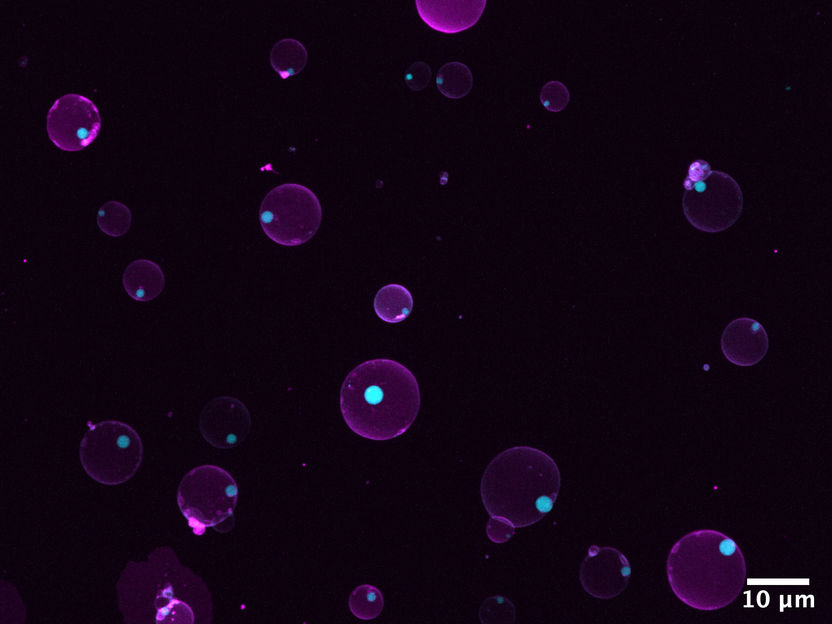Let’s build a cell
Researchers engineer a minimal synthetic cellular system to study basic cell function
cells are the basic unit of life. They provide an environment for the fundamental molecules of life to interact, for reactions to take place and sustain life. However, the biological cell is very complicated, making it difficult to understand what takes place inside it. One way to tackle this biological problem is to design a synthetic minimal cell as a simpler system compared to biological cells. Researchers at the Max Planck Institute of Molecular Cell Biology and Genetics (MPI-CBG) in Dresden and the Max-Planck-Institute of Colloids and Interfaces (MPICI) in Potsdam accomplished such an engineering challenge by building a synthetic cell that can encapsulate fundamental biochemical reactions. They also show that such a minimal system can respond to changes in environment.

Synthetic cells with compartments. Magenta shows the lipid membrane, cyan shows the fluorescently tagged membrane-free sub-compartments.
Copyright: Love et al. / MPI-CBG
Cells make up the basic building blocks of life. They provide a distinct and dynamic environment for the organization of molecules and reactions that are needed to sustain life. Inside the cell there are countless molecules including DNA, proteins, sugars, and fats (lipids) that need to come together in different ways. To understand, how cells organize all these components to function in a complex environment, scientists have been building synthetic cells with fewer components to engineer simple systems that mimic certain cellular processes. This research field of synthetic biology combines engineering and biology and focuses on taking parts of the natural biological system and simplifying it.
Despite much progresses in the synthetic biology field, building dynamic systems is still very difficult. The research team, funded through the MaxSynBio network, made up of MPI-CBG research group leader Dora Tang in collaboration with MPICI research group leaders Rumiana Dimova and Tom Robinson have now accomplished this engineering challenge and built a synthetic cell that can react to changes in the environment. The researchers constructed a compartment with a membrane that contains a membrane-free sub-compartment inside it. This sub-compartment can assemble and disassemble depending on changes to the environment. The key challenge during this process was to create a sub-compartment from molecules that were floating within the synthetic cell. These cells were visualized by fluorescence microscopy. Celina Love, the first author of the study, explains: “Just like our taste buds can let us experience tastes that are salty or sour, components inside a cell can also respond to the acidity (pH) of an environment. We found that by changing the pH of the environment, we can affect the behavior of molecules coming together and their ability to form sub-compartments. It was especially exciting to see how chemical reactions could be switched on and off by changing the acidity within the synthetic cell.”
Dora Tang, the supervisor of the study, gives an outlook: “Our work is a major step forward in the design of more complex synthetic cells that can mimic biological behaviors.” She adds: “This tunable synthetic system presents exciting possibilities in addressing fundamental questions in biology, such as how cells integrate a multitude and variety of signals from the environment to perform and tune basic cellular functions such as metabolism.”



















































